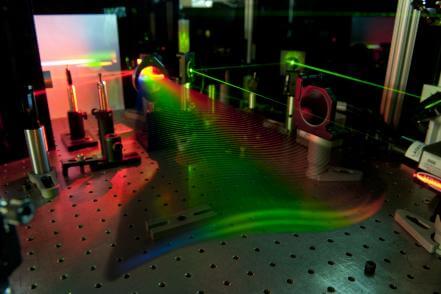Michigan State University researchers are promoting the possibility of using lasers to detect explosives at security checkpoints.

Michigan State University researchers are promoting the possibility of using lasers to detect explosives at security checkpoints.
Michigan State University (MSU) chemistry professor Marcos Dantus and founder of the company 'BioPhotonic Solutions' has developed a laser capable of detecting extremely small amounts of explosives found on clothing and luggage.
"In light of the fact that this method uses a single beam and does not require any use of a large instrument such as a spectrometer, it is a quite practical method that allows a large number of people and their cargo to be scanned quickly," said the lead researcher. "Not only can this method be used to locate the explosive, but it also provides a picture of the exact location of the chemical, even if it is there in an extremely small amount."
More on the same topic on the science website:
- Technion researchers have discovered an effective method for detecting explosives
- A sensor for detecting explosives hidden in shoes
- 132 years since the birth of Gideon Sandbeck - the zipper key
The intention is not that the security forces will be equipped with manual lasers at the airports, but that the laser will be installed inside the baggage conveyor belt, similar to the X-ray scanners that are already used in airport security checks. The researcher adds and says that the laser that uses low energy is safe for both the luggage and the passengers themselves.
For many decades scientists have been working on developing lasers that would be powerful and sensitive enough to detect explosives, and safe enough to use on humans. The researchers' initial motivation for this breakthrough came from a collaboration they carried out with Harvard University where researchers developed a laser capable of being used to detect cancer, pinpointing its location. "While we were working on biomedical imaging, I started looking at additional applications," said the lead researcher. "We soon realized how effective this laser is for locating small residues of dangerous substances from a distance of up to ten meters from them."
The state-of-the-art laser is indeed a single beam, but it uses two pulses. The first pulse reacts with specific frequencies of the chemical found in the explosives. The second pulse, which is a much less energetic pulse, is used as a reference value. The gap between the readings of these two pulses indicates the presence of the explosive. "The laser is not affected by the color or texture of the clothes or luggage," explains the lead researcher. "The two pulses are permanently in equilibrium between them, unless an explosive is detected. Our method has chemical selectivity, excellent sensitivity and robust performance on any surface."

One response
Nothing is written clearly about the process